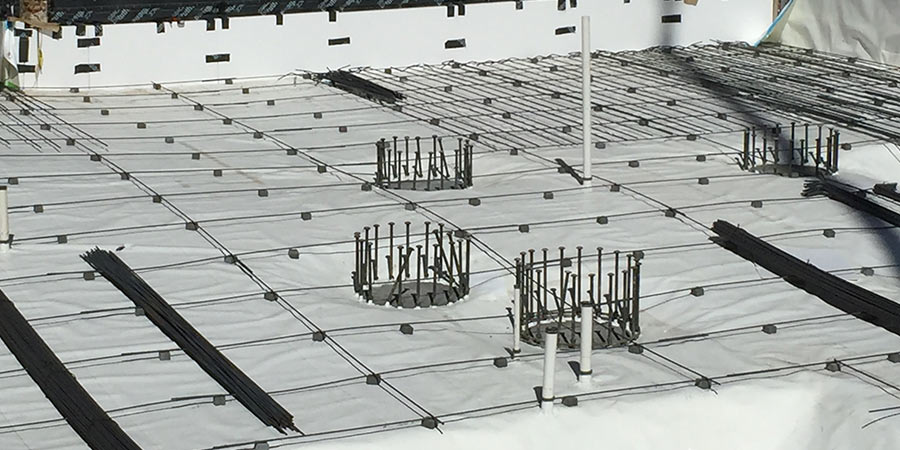
Developers are increasingly facing the challenge of protecting new structures from harmful gases in the soil. Even when layers of soil are removed from industrial sites and other brownfields, gas barrier protection is often still needed because a certain amount of vapors remain that may be harmful to human health.
Emerging standards to protect against methane and other gases
In the UK, standards such as BS8485:2015 have already been developed that provide guidance for site investigations and to identify acceptable levels of methane gas and carbon dioxide in the soil. In addition, the City of Los Angeles has adopted Ordinance 175790, which states in part that building permits within certain “methane zones” will not be issued until the submittal of detailed plans for the installation of suitable methane mitigation systems. We are likely to see similar regulations emerge in other locations in the coming years.
Protective measures against harmful gases
Certain waterproofing systems such as PREPRUFE® Plus system offer not only water and moisture protection but also protection from gases such as methane, carbon dioxide, and radon. This type of system is applied below grade, prior to the pouring of the concrete and is highly effective and efficient as it provides the dual benefit of waterproofing and gas protection in a single layer. As the concrete is poured, it passes through the surface layer of the PREPRUFE® Plus membrane. The concrete then engages with the membrane’s pressure sensitive adhesive. As the concrete hardens, the bond between the concrete and the membrane become permanent. By creating an integral bond with poured concrete, the waterproofing membrane provides a barrier to water, moisture, and gas.
Pre-applied bonded membranes are usually the most cost-effective way to minimize the amount of gases that enter the structure. In the absence of this type of membrane, builders typically are forced to vent in layers and add granular fill below the slab so that the gases can freely escape the structure. This is a time-consuming and expensive endeavor.
A real-world example of gas vapor barrier protection
A property management company was looking to develop residential use buildings on the former site of an auto body repair shop in Brooklyn. Before embarking on the project, they sought out an environmental professional and an engineer to develop a remediation action plan for the site. They also worked with the NYC Office of Environmental Remediation to investigate and remediate the site.
Soil vapor samples from the site indicated elevated levels of petroleum-related volatile organic compounds (VOCs) and chlorinated VOCs. To limit the migration of soil vapor into the dwelling, the engineer and environmental professional specified the installation of a vapor barrier/waterproofing system below the concrete slab, sub-grade foundation sidewalls, and below the elevator pit and elevator pit sidewalls. The project also specified that welds, seams, and penetrations are to be properly sealed to prevent other pathways for vapor migration.
Evaluating options for vapor gas barriers
Before specifying a water and gas barrier, talk with engineers, environmental professionals, and local environmental officials who are well versed in the latest remediation techniques and regulations. Also, be sure to investigate what tests have been done to validate the manufacturer’s claims about the gas remediation performance of their products. It’s essential that the product(s) are able to mitigate gases below the threshold designated by local environmental regulations. These regulations will vary from country to country, and sometimes even vary by state.
Learn more about PREPRUFE® Plus waterproofing membrane
Related articles
March 28, 2018
Waterproofing structures in extreme climates
Poised at the end of Doha Bay, the Museum of Islamic Art rises from the waters of the Arabian Gulf. The climate and corrosive salt environment of the Persian Gulf created a number of challenges for th...
READ MOREAugust 29, 2018
Soil Contamination and its Impact on Indoor Air Quality
People can be exposed to soil contaminants in a number of ways, including: Breathing VOCs that intruded into the home or into the outdoor air Absorbing chemicals through their skin when coming in ...
READ MOREApril 03, 2018
Providing mission-critical waterproofing
Many structures need to be waterproofed to protect against deterioration, but what if you have a building that needs to be kept very dry? How do you safeguard critical property and assets from water i...
READ MOREMay 28, 2018
Pre-applied Waterproofing: Understanding concrete bonding methods
Pre-applied waterproofing is used below basement slabs and behind walls on job sites where there is limited space for excavation and heavy equipment. Instead of pouring the foundation and then applyin...
READ MORETags
- Building Envelope Solutions
- PREPRUFE PLUS
- Structural Solutions
- Sustainability
- Waterproofing